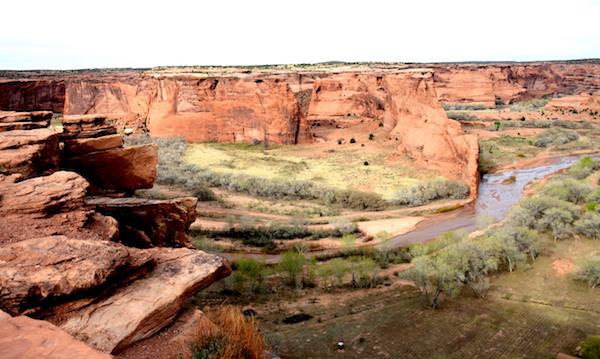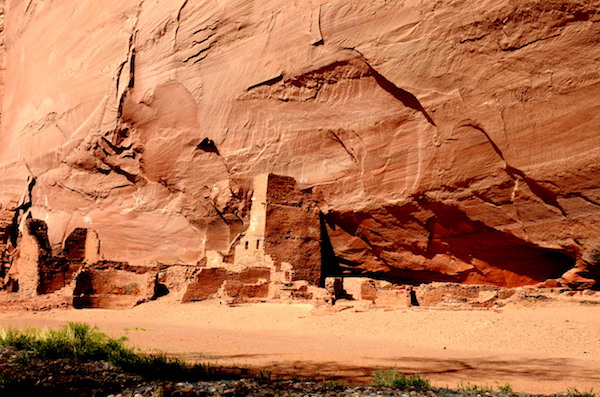 |
Canku Ota
|
 |
|
(Many Paths)
|
||
|
An Online Newsletter
Celebrating Native America
|
||
|
January 2017 - Volume
15 Number 1
|
||
|
|
||
|
Canyon De Chelly:
Stunning Views And A Window Into Ancient Lives
|
||
|
by Jack McNeel - Indian
Country Today Media Network
|
||
It has been inhabited contiguously for nearly 5,000 years, is the only National Monument owned by the Navajo Nation, and contains thousands of archaeological sites. Yet next to its cousins—the Grand Canyon, Bryce and Zion national parks, and Monument Valley Park on the Navajo Reservation, where so many westerns have been filmed—Canyon De Chelly often gets overlooked by people visiting the Southwest. All are wonderful inclusions for any vacation, but Canyon De Chelly offers an identity unlike anything the others offer, and it's also part of the Navajo Reservation. "The Anasazi were here from 2500 B.C. to 1300 A.D.," said Leon Skyhorse Thomas, founder of Canyon De Chelly Tours, one of the first companies to offer private tours in the canyon. "The Hopis were here from 1300 to 1600 A.D., and the Navajo from 1600 to the present day. People have been living in Canyon De Chelly for nearly 5,000 years. It's the oldest inhabited area within the Colorado Plateau." Canyon de Chelly is the only national monument in the U.S. that is not owned by either the Department of Interior or National Park Service. Navajo people own the land. The National Park Service protects and preserves the numerous archeological sites and historical sites in cooperation with the Navajo Tribe. Touring the canyon with a Navajo guide is an experience you'll never forget. Thomas is one such guide. Born just south of the canyon and raised in a traditional family, he began working as a guide in Canyon De Chelly in 1988 and formed his own company in 1993. The website for Canyon De Chelly Tours averages about 225 hits per day, making it a major player in the tourism business. The company's tours are information-packed, and are unique from the second visitors climb aboard four-wheel-drive vehicles with their guide and proceed into the canyon. Much of the "road" is actually the stream that flows through the canyon; vehicles drive right up the stream. The guides know where to drive and what to avoid. Quicksand is not really a threat, but throughout the years more than 20 vehicles have become stuck and remain submerged beneath the sand. The canyon is huge, 131 square miles, Thomas said. Side canyons merge into the main canyon, and the tour continues upstream. The deep reds of the cliffs form a wonderful backdrop to the vegetation carpeting the canyon floor. "Over 2,700 archeological sites and over 700 ruins are in the
canyon," Thomas explained, pointing out some of the petroglyphs
along the canyon walls. "The Hopi chain coming down represents the
snake clan. The four-leaf clover on the bottom represents the coyote
clan. A few feet above you have a Hopi Snake dancer. The horses
are Navajo. Horses were introduced to the southwest by the Spanish,
and the first military expedition was in 1539. That petroglyph on
top is the arrival of the Spanish. The broad shoulders represent
the Spanish breastplate."
The canyon walls are reddish and frequently overhang the stream. A number of Navajo families live here, their alfalfa, corn, bean and squash fields flashing in and out of view from the road. The word 'chelly' comes from the Spanish from a Navajo word, tséyi, which means 'canyon.' The most famous of the ruins are Antelope House Ruin and White House Ruin. Visitors aren't allowed within these ruins, but guides will take you near it for photos and a chance to see the structures up close. A road also leads around the perimeter, offering a number of views into the canyon from above. Though a drive around the edge yields beautiful views, it is no match for the feelings generated from touring the canyon floor with its many petroglyphs, ruins and close-up views of the canyon walls, in addition to the drive up the stream bottom itself. "Canyon De Chelly has a charm," said Donovan Hanley, director of sales for the Navajo Nation. "It's not as grand as Grand Canyon, but when people are here, it's, 'Wow, this is here!' " And it isn't completely undiscovered, logging its share of visitors, especially so-called snowbirds from the northwest and Canada who stop if they're wintering in southern Arizona, Hanley said. "It's authentic and unique," he said. "They want to bring their families. We see a lot of multigenerational trips where grandparents are traveling with their grandkids. When people come out it's, 'Wow! Why haven't we done this sooner?' " Canyon De Chelly adjoins Chinle, Arizona. Thunderbird Lodge sits right at the entrance to the canyon and is now owned by the Navajo Tribe. It's an older facility but is currently being reconditioned from the inside out and is beautifully done. The adjoining tribal cafeteria offers good food for moderate prices. Thomas uses the location to meet his customers before the trip into Canyon De Chelly. "It's hard to visit the southwest without hitting the Navajo Nation at some point," said Hanley, noting that the motel is one of four owned by the tribe. "We grasp that tourism hand quicker than some of the smaller tribes. Thunderbird Lodge is a really good venture because it's under the National Parks Service, so our partnership is heightened a bit more. They're glad someone is here at the property, and the fact that it's a Navajo Nation entity is better, because who better to tell the story than Navajo Nation itself?" |
|||||||
|
|
|
|
||
|
|
||
| Canku Ota is a free Newsletter celebrating Native America, its traditions and accomplishments . We do not provide subscriber or visitor names to anyone. Some articles presented in Canku Ota may contain copyright material. We have received appropriate permissions for republishing any articles. Material appearing here is distributed without profit or monetary gain to those who have expressed an interest. This is in accordance with Title 17 U.S.C. Section 107. | ||
|
Canku Ota is a copyright ©
2000 - 2017 of Vicki Williams Barry and Paul Barry.
|
||
 |
 |
|
|
The "Canku
Ota - A Newsletter Celebrating Native America" web site and
its design is the
|
||
|
Copyright ©
1999 - 2016 of Paul C. Barry.
|
||
|
All Rights Reserved.
|
||


